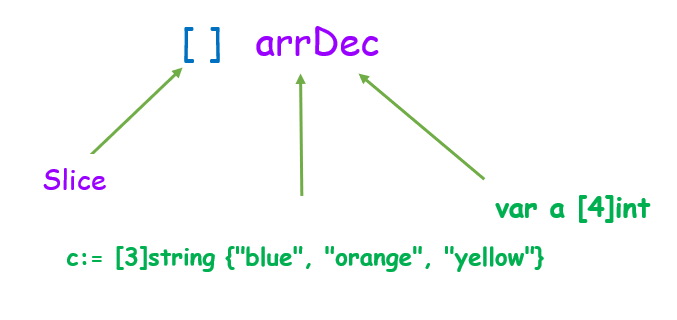


In this tutorial, we will be discussing the Go slice data type which falls under the reference data type of composite types. Here you will gain knowledge of what exactly is a slice in Golang, their definition and declaration syntax in Golang, copy, append, move functions used in Golang, etc
A slice is a reference type data structure that represents a sequence of elements of the same type of an existing or underlying array. A slice refers to a piece or section of an existing array. Like arrays, a slice does not have its own data it only provides a reference to a particular section of data/elements in an array.
Let us understand the slice concept in an easier manner with a simple Array representation:

The above figure shows an array “A” with index 0, 1, 2………9.Each array index stores some string-type elements. For example, an array with index 0, A [0] contains “LET”, A [1] contains “US” etc….(for better understanding of array refer to array tutorial).
Now let us understand how the slice works with the array. Array A is going to be partitioned into two slices. The two slices Slice 1 & slice 2 of A form subset of the underlying array.

Declaration of the slice is similar to an array. The only exception compared to the array is the size of the slice needs not be prespecified.
For eg the square [ ] bracket remains empty in slice declaration while in the case of arrays some values are specified inside the square bracket like [5],[7] to initialize the array size. Based on slice requirements the size of the slice expands and compresses accordingly.
Syntax :
An empty square bracket [ ], followed by any of the declaration types discussed in the array tutorial.
[ ] arrDec
Or
[ ] arrDec{ }
Or
[ ] arrDec{value1, value 2, value 3 …………..value m}
In the above syntax, arrDec represents the types of selected array declaration.

package main
import "fmt"
func main() {
// Creating a slice
// using the var keyword
var slice1 = []string{"learn", "e", "tutorials"}
fmt.Println(" Slice 1:", slice1)
// Creating a slice
//using shorthand declaration
slice2 := []int{ 67, 67,56,98, 43 }
fmt.Println(" Slice 2:", slice2)
}
Output:
Slice 1: [learn e tutorials] Slice 2: [67 67 56 98 43]
Make function in Golang creates a new slice. It is a built-in function.
Syntax :
make([]arrDec, len, cap) []arrDec
package main
import "fmt"
func main() {
// Creating slice using make function
A := make([]string, 5)
//initially empty
fmt.Println("array A is: ", A)
//assigning values to slice array
A[0] = "Golang"
A[1] = "in"
A[2] = "learn"
A[3] = "e"
A[4] = "tutorials"
fmt.Println("slice created using make(): ", A)
}
Output:
array A is: [ ] slice created using make(): [Golang in learn e tutorials]
Explanation:
package main
import "fmt"
func main() {
// Creating an array
A:= [10]string{"Let", "us", "learn", "Go",
"programming", "language", "with","learn ","e","tutorials"}
// Display array
fmt.Println("Array A:", A)
// Creating a slice
slice1:= A[2:6] // start from index 2 till 5
slice2 :=A[:2] //start from index 0 till 1 excludes index 2
slice3 := A[7:] //start from 7 till ending index
slice4 := A[:]
// Display slice
fmt.Println("Slice 1 is :", slice1)
fmt.Println("Slice 2 is :", slice2)
fmt.Println("Slice 3 is :", slice3)
fmt.Println("Slice 4 is :", slice4)
}
Output:
Output Array A: [Let us learn Go programming language with learn e tutorials] Slice 1 is : [learn Go programming language] Slice 2 is : [Let us] Slice 3 is : [learn e tutorials] Slice 4 is : [Let us learn Go programming language with learn e tutorials]
The slice internals is the components that make up a slice. A slice is internally represented with a pointer to the array, with its length and capacity. We know slice is a segment of an array with these three components so it can be generalized with the below syntax.
type Slice struct {
array unsafe.Pointer
cap int
len int
}
A pointer points to the initial element of the slice in the array. In the given example for slice 1 containing elements
[“LEARN”,” GO”,” PROGRAMMING”,” LANGUAGE]

Here initial or beginning element is learned with index 2 so the pointer points to that location. Therefore pointer is set to 2
The length of the slice is the number of elements in the slice.len() function in the slice is used to determine the length of a slice. In the below-given slice 1, there is a total of 4 elements starting from the beginning. Therefore length is set to 4.
Slice1 ---- > [“LEARN’ “Go”,” PROGRAMMING” “LANGUAGE “]
len(slice1) returns the number of elements present in slice 1 ie, len(slice1) call returns a value 4
The capacity of a slice is the maximum number of elements in the underlying array. cap() function in slice determines the capacity of the slice.In the below example start counting from the beginning of slice1 elements till the end of the underlying array

So counting from slice 1 index beginning till array ending position denotes the capacity for an above slice which returns an integer value 8. It can be denoted as cap(slice) =8.
The below picture depicts the internal components of slice 1 with pointer points to array address 2, length of the segment is 4, and capacity of slice 1 is 8 since slice 1 is a segment of Array A with actual size 10 (0,1,2…..9 index) in which index from 2 to 5 segment form slice1 together with the remaining index starting from 6 to ending at index 9 forms the total capacity i.e. capacity equals to 8. (with respect to the above example discussed)

Let us understand the above-discussed len( ) and cap( ) function using Golang. The same description we have discussed is coded in the below Go program.
package main
import "fmt"
func main() {
// Creating an array
A:= [10]string{"Let", "us", "learn", "Go",
"programming", "language", "with","learn ","e","tutorials"}
// Display array
fmt.Println("Array:", A)
// Creating a slice
slice1:= arr[2:6] //slicing array
// Display slice
fmt.Println("Slice 1 is :", slice1)
// Display length of the slice
fmt.Printf("Length of the slice 1: %d", len(slice1))
// Display the capacity of the slice
fmt.Printf("\nCapacity of the slice 1: %d", cap(slice1))
}
Output:
Output Array A: [Let us learn Go programming language with learn e tutorials] Slice 1 is : [learn Go programming language] Length of the slice 1: 4 Capacity of the slice 1: 8
Append () function is a built-in function in a slice that appends elements to a slice.
Alternatively, append () allows expanding the size of the slice.
package main
import "fmt"
func main() {
// slice creation using make()
A := make([]string, 3)
//dispplays initial slice values
fmt.Printf("slice:%v; len: %d; cap: %d \n", A, len(A), cap(A))
fmt.Println("---------------------------")
//performs appending values to slice A
A = append(A, "Go")
A = append(A, "Lang")
A = append(A, "in")
A = append(A, "learn", "e", "tutorials")
//display slice after insertion
fmt.Printf("slice: %v; len: %d; cap: %d \n", A, len(A), cap(A))
}
Output:
slice:[ ]; len: 3; cap: 3 --------------------------- slice: [ Go Lang in learn e tutorials]; len: 9; cap: 12
Copy () function is a built-in function that allows copying elements from one slice (source slice) to another slice (destination slice).
package main
import "fmt"
func main() {
// slice creation using make()
A := []string {"Go", "lang"}
B :=make([]string,len(A))
//displays initial slice values
fmt.Printf("Initial slice A:%v; len: %d; cap: %d \n", A, len(A), cap(A))
fmt.Println("---------------------------")
copy1 := copy(B,A)
//display slice after COPYING
fmt.Printf("%d elements copied\n", copy1)
fmt.Printf("slice after copying to B: %v; len: %d; cap: %d \n", B, len(B), cap(B))
}
Output:
Initial slice A:[Go lang]; len: 2; cap: 2 --------------------------- 2 elements copied slice after copying to B: [Go lang]; len: 2; cap: 2
In the above program copied slice is declared in A to slice B of string type by using the copy( ) function.
In slice for loop is used for iteration among slice elements.
package main
import "fmt"
func main() {
tutorial := []string{"Go", "Programming", "language", "in", "learn", "e","tutorials"}
for a, tutorial := range tutorial {
fmt.Println(a, tutorial)
}
}
Output:
0 Go 1 Programming 2 language 3 in 4 learn 5 e 6 tutorials
| S.No | ARRAY | SLICE |
|---|---|---|
| 1 | Array stores sequence of elements of the same type | Slice does not store any data |
| 2 | The array has a fixed size | Slice is flexible can be resized |
| 3 | Arrays are less used in Go | Slice is most used in Go |
| 4 | Array copies refer to different underlying data | Slice copies refer to the same underlying data |